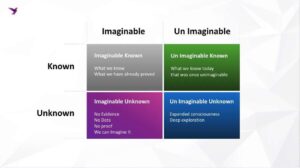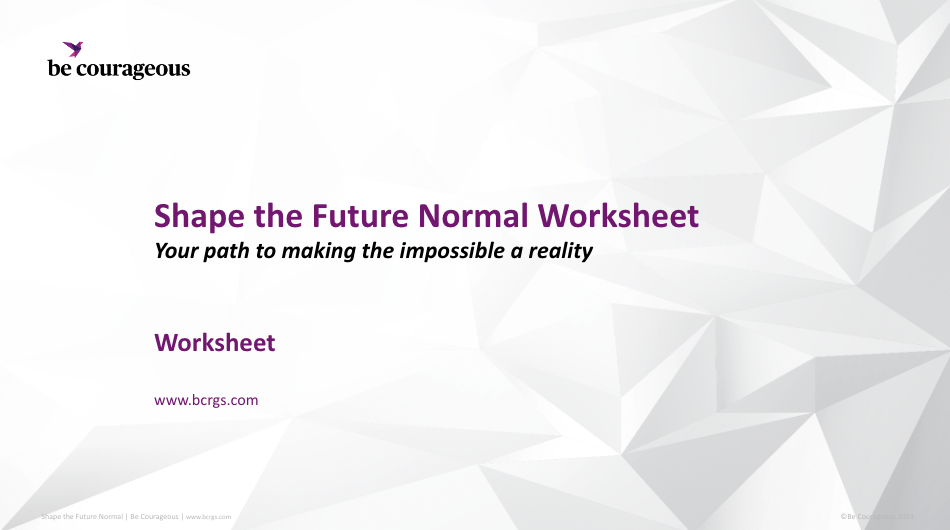What was once unheard of is now mundane. Here's how you can shape the future by moving the unimaginable into the known.
The human desire to want to know the future is a tale as old as time. It’s why there are movies like Minority Report, Back to the Future, and Interstellar, and why resources like the Farmer’s Almanac, tarot cards, psychics, astrology, and heck, even the “Magic Eight Ball” were invented. (“Reply hazy, try again.”)
Even in ancient Egypt people used the method of “scrying” to predict the future by looking into a reflective surface to visualize events.
For the record, we think all of these methods can serve a purpose in the right context.
Humans love predictability
Not knowing the future makes us humans pretty anxious. We love familiarity, comfort, and certainty, and we’ve done a bang-up job to decrease life’s discomforts.
In fact, almost all human comfort and survival issues already have solutions — they just may not be evenly distributed yet.
From light bulbs to air conditioning, and remote controls to motorized vehicles, we love making things easier for ourselves.
We also crave routines. We find comfort in our favorite route to work, knowing our favorite item on a menu, and watching the same movie over and over. We develop (or try to develop) consistent bedtime routines for ourselves and our children.
Staring into the unknown and unexpected changes makes us nervous. Whether it’s anticipating how an important conversation will play out, how a job will change during a re-org, or what product lines to invest your team’s energy in to be future-ready, sometimes we feel like screaming, “Just show me some signs!” into the abyss.
Humans (also) love invention
In contradiction, humans also crave whatever the newest, hottest gadget or method is. They rarely want to be the ones to create the newest thing, but they sure love to judge and be the critic of “the new.”
Humans want conveniences, rituals, and routines, but not many look at the consequences of those inventions on the planet and society. And the world is showing signs of this lack of mindful thinking.
So how can we manage the conflict of preferring comfort and stability with the anxiety-inducing thrill of seeking the unknown?
Enter: Be Courageous’ “Shape the Future Normal” Method
I’ve spent decades working with people on the front lines of the unknown, in innovative industries from energy to tech to defense to space, and beyond. No industry is impervious to the nature of change. From cosmetics to food, every single industry is being disrupted every day. That is inevitable. And it is the new normal. [Totally up for debating this, by the way!]
To help, we’ve developed a method to courage the future and turn the unknowns from stressful what-ifs into opportunities, even when the future is as unclear as a mud-covered window.
Here’s what the method looks like:

Imaginable Known
The imaginable known refers to what already is and has been proven. Spending time developing in this part of the quadrants means you’re generally coming up with improvements to what already exists.
For example, take an existing game like soccer or tennis. It has its rules and place of play, but there are many ways you can imagine new ways to play within the existing system.
Another example is we know people like to drink juices with fruit-flavored infusions. One company might develop certain flavor profiles, and another might adjust the flavors and call it something new, or make it calorie-free. But these developments are happening in a market that is known and proven desired by humans.
A proven, successful way to win in this quadrant is the principle of the Red Ocean / Blue Ocean Strategy.
Red Ocean / Blue Ocean Strategy
Red Ocean is the color of blood (I know, a little gross, but effective) because many people are in the space competing with the current functions, features, and benefits of a specific industry.
Blue Ocean is a territory that has no competitors.
If you want to move out of the Imaginable Known quadrant, you would ask, “What can I add that doesn’t exist?” What is something I can remove?” What is something I can increase or decrease that would create a Blue Ocean – a new territory that has no competitors?”
Unimaginable Known
The unimagined known are inventions that were once unimaginable but now exist. Like buying a house from your phone (or 3D printing a 3k square foot house in 48 hours!), the ability to communicate with anyone in the world at any time, and answers to any question you may ever have within seconds.
The main issue to figure out in this quadrant is: How fast and widespread will people adopt the unimaginable?
The opportunity in this quadrant is to find ways to fully utilize or leverage a new technology, product, or service (Like AI). And create access or a solution that could result in mass adoption which ends up being the “new normal.”
Imaginable Unknown
In the imaginable known, our mind can envision a certain future without knowing how it could work or if it’s possible. There’s no data, evidence, or proof, but we can see it in our mind’s eye.
This is where you might think, “Wow, in my wildest dreams!” Like flying cars, a device that can diagnose any illness by pointing it at a person, time travel, or, before we did it, going to the moon (now that event is in the unimaginable known category.)
An effective exercise I do in sessions with teams on this topic is to offer a prompt that seems outlandish.
I’ll say something like: “Let’s solve climate change in 60 seconds with no proof or data that tells us the idea is possible. But you can imagine it.”
The amount and types of ideas that flow when people have permission to brainstorm without needing to back any thought up with evidence is incredible.
Try this exercise with your team with openness and curiosity, and see what happens. Don’t interject with loopholes; usually what blocks great innovation is when an idea is dismissed because it may not work.
Choose an idea that feels incredibly intriguing, new, and extremely low on feasibility, that would take a lot of courage to make happen.
Working to solve today’s conditions from an imagined but unknown future is when you’ll start to turn the impossible into the everyday.
Unimaginable Unknown
The unimaginable unknown is the most difficult quadrant to access; it’s the area of, “We don’t know what we don’t know.” In this unknown, the purest form of ideas and inventions live. They live in a realm with no existing system, and they haven’t even yet reached our imaginations. But they are there!
For example, let’s say we’re thinking about the world of health care. The way to tap into the unimaginable unknown, we could ask, “What will the meaning and definition of health be in 100 years?” Just that question alone will take you on a pretty adventurous journey!
Ask a question that has no prescribed answer, which requires deep contemplation, exploration, and intense curiosity, to access this area.
Shape the future normal: You have the tools
We have the most access and tools at our disposal than anyone has ever had before to make a positive impact.
So what do we do with them?
You should have a position in all quadrants.
Start playing in the unimagined unknown. What’s your deep question?
See how it starts to inform the imagined unknown.
Then, find out what grabs you and what you would want to see as a new normal. Start taking action towards that, and you will move it to the once unimagined, now known.
Congratulations, you’ve put a brand new idea in the world. And if it adds meaning and value to people’s lives, and people adopt it, it will become the imagined known.
Whether you’re a “possibilities person,” easily generating ideas even with no evidence or data, or are an “evidence-only ” person, we need both.
Try all the hats on. A groundbreaking idea will stay stuck in the land of ideas without action.
If you don’t trust what you can’t see, you’ll always make decisions based on the imagined known and miss giant opportunities in all the other quadrants.
Now, it’s your turn to shape the new normal. Creators, we need you!
Co-writer: Shannon Geher//Research: FIN
Shape the Future Normal Tool
Your free guide to taking the once unimagined into the new normal.
Courageous Relationships
Workshop Series
In this eight-week interactive workshop and coaching series, your team will elevate trust, collaboration, and performance.



